Langkawi
Langkawi, officially known as Langkawi, the Jewel of Kedah (Malay: Langkawi Permata Kedah), is a district and an archipelago of 99 islands (+ 5 small islands visible only at low tide) in the Andaman Sea some 30 km off the mainland coast of northwestern Malaysia. The islands are a part of the state of Kedah, which is adjacent to the Thai border. On 15 July 2008, Sultan Abdul Halim of Kedah consented to the change of name to Langkawi Permata Kedah in conjunction with his golden jubilee celebration. By far the largest of the islands is the eponymous Langkawi Island (Pulau Langkawi), with a population of some 64,792; the only other inhabited island being nearby Tuba Island.
Langkawi District | |||||||||||||||||||||
|---|---|---|---|---|---|---|---|---|---|---|---|---|---|---|---|---|---|---|---|---|---|
| Daerah Langkawi | |||||||||||||||||||||
| Other transcription(s) | |||||||||||||||||||||
| • Jawi | لڠكاوي | ||||||||||||||||||||
| • Chinese | 浮罗交怡县 | ||||||||||||||||||||
| • Tamil | லங்காவி | ||||||||||||||||||||
 Location of Langkawi in Kedah | |||||||||||||||||||||
 Langkawi District Location of Langkawi in Malaysia  Langkawi District Langkawi District (Peninsular Malaysia) | |||||||||||||||||||||
| Coordinates: 6°21′N 99°48′E | |||||||||||||||||||||
| Country | |||||||||||||||||||||
| Seat | Kuah | ||||||||||||||||||||
| Local area government(s) | Tourism City of Langkawi Municipal Council | ||||||||||||||||||||
| Area | |||||||||||||||||||||
| • Total | 478.48 km2 (184.74 sq mi) | ||||||||||||||||||||
| Population (2010)[2] | |||||||||||||||||||||
| • Total | 85,588 | ||||||||||||||||||||
| • Density | 180/km2 (460/sq mi) | ||||||||||||||||||||
| Time zone | UTC+8 (MST) | ||||||||||||||||||||
| • Summer (DST) | UTC+8 (Not observed) | ||||||||||||||||||||
| Postcode | 07xxx | ||||||||||||||||||||
| Calling code | +6-09 | ||||||||||||||||||||
| Vehicle registration plates | KV | ||||||||||||||||||||
| |||||||||||||||||||||
Langkawi is also an administrative district, with the town of Kuah as its largest town. Pentai Cenang is the most popular beach and tourist area in Langkawi, with tens of thousands of visitors each year.[4]
Etymology
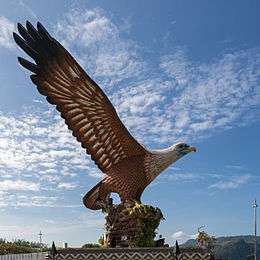
The name Langkawi is thought to have existed by the early 15th century, although in the 16th century the island of Langkawi was also marked on maps variously as Langa, Langka, Lansura, and Langapura.[6]
There are many suggestions for the origin of the name of Langkawi. According to one interpretation, Langkawi means island of the reddish-brown eagle, a Brahminy kite in colloquial Malay.[7] The Malay word for eagle is helang (shortened to lang), and kawi is a red stone used as a chalk to mark goods.[6] This interpretation was used to create the landmark sculpture of an eagle as the symbol of Langkawi at Dataran Helang (Eagle Square) in Kuah.[8][9]
Some believed that Langkawi is the same as, or related to, the Lanka or Langkapuri mentioned in Indian sources.[10] This ancient name Lanka (or Lankapura and Lankapuri) is found in Indian literature from an early period (named in Ramayana as the city of the king Ravana), although the identification of the original Lanka is not certain.[11] Puri or puram in Sanskrit means a town or city. The name Langkawi is also thought to be related to Langkasuka, an old kingdom thought by some to have links with Kedah.[12] Some also thought that Langkawi means "many beautiful islands", langka being a Sanskrit word meaning "beautiful" while wi means "many".[6]
In 2008, the then-sultan of Kedah, Abdul Halim Mu'adzam Shah, conferred the title of Langkawi Permata Kedah (meaning "Langkawi, the Jewel of Kedah") upon the island as part of his golden jubilee as an affirmation of Kedah's ownership over the island.[13]
History
Langkawi had long been at the periphery of, but closely associated with, the domain of the Kedah Sultanate. Legend tells of a great snake ular besar, the custodian of the Langkawi Islands, to which a new king of Kedah must sacrifice a virgin daughter whenever he first ascended the throne, or when a war was declared with another state.[14]
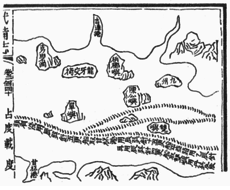
The island of Langkawi was recorded in history by various travelers to the region. It was called Lóngyápútí (龍牙菩提) in the 14th century by the Yuan dynasty traveler Wang Dayuan, and when the Ming dynasty admiral Zheng He visited the region, the island was marked as 龍牙交椅, Lóngyájiāoyǐ, in his map. In the 15th century, it was known to the Acehnese as Pulau Lada "Pepper Island" as they came over to plant pepper. In 1691, the French general Augustin de Beaulieu recorded going to the island of "Lancahui" (Langkawi) to buy pepper,[12] and de Beaulieu was required to obtain a license from Kedah's heir apparent then in Perlis before the penghulu or chief of Langkawi would sell pepper to him.[15]
Langkawi was historically home to seafarers, such as the orang laut or sea people originally from the southern part of the Malay Peninsula, as well as pirates and fishermen. It had been thought to be cursed for a couple of centuries - according to local legend, in the late 18th century, a woman named Mahsuri was wrongfully accused of adultery and put to death, and she placed a curse on the island that would last for seven generations.[16] Not long after Mahsuri's death, in 1821, the Siamese army invaded Kedah, and attacked Langkawi. In the first attack, the locals decided to burn down the granary at Padang Matsirat to starve and drive out the Siamese army. The Siamese nevertheless finally captured the island in May 1822, killed its leaders, and many of the islanders were taken as slaves, while others were forced to flee.[17] Before the Siamese invasion, there was an estimated island population of 3–5000, and only a small proportion was left after the invasion.[18]
The island was recaptured from Siamese rule in a campaign against the Siamese in 1837. In 1840–1841, the Sultan of Kedah, who went into exile after the Siamese attacks, was allowed to return by the Siamese, and the population of Langkawi islands recovered afterwards mainly due to settlement of immigrants from Sumatra. However, the Orang Laut who fled after the Siamese attacks did not return.[19] In 1909, the islands came under British rule under the Anglo-Siamese Treaty of 1909. The middle of the channel between Tarutao National Park and Langkawi would become the Siamese border, and Tarutao would be part of Siam while all the Langkawi islands to the south would come under British rule. During the World War II, Siam took control briefly as British Malaya fell to the Japanese.
Langkawi had been a haven for pirates which affected the northern part of the Strait of Malacca. In a series of operations, between December 1945 and March 1946, the British cleared the pirates' land base in Langkawi and Tarutao.[20] The British continued to rule until Malaya gained its independence in 1957.
Langkawi remained as a quiet backwater until 1986, when the then Prime Minister Mahathir Mohamad decided to transform it into a major tourist resort, helping to plan many of the islands buildings himself.[21] The curse placed by Mahsuri for seven generations was said to have lifted as the 7th generation descendant of Mahsuri who now lives in Phuket Province was born.[22] The island rapidly grew as a tourist destination, and by 2012, it had received over 3 million tourists a year.[23][24]
Geography
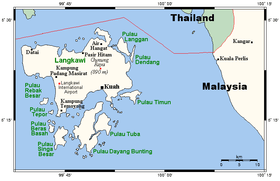
Langkawi, a cluster of 99 islands separated from mainland Malaysia by the Strait of Malacca, is a district of the state of Kedah in northern Malaysia and lies approximately 51 km west of Kedah. The total land mass of the islands is 47,848 hectares. The main island spans about 25 km from north to south and slightly more for east and west. The coastal areas consist of flat, alluvial plains punctuated with limestone ridges. Two-thirds of the island is dominated by forest-covered mountains, hills and natural vegetation.[25]
The island's oldest geological formation, the Machinchang Formation, was the first part of Southeast Asia to rise from the seabed in the Cambrian more than half a billion years ago. The oldest part of the formation is observable at Teluk Datai to the north-west of the island, where the exposed outcrop consists of mainly sandstone (quartzite) in the upper parts and shale and mudstone in the lower parts of the sequence.[26] In fact, the best exposure of the Cambrian rocks (541 to 485 Ma) in Malaysia is the Machinchang Formation – made up of quartzose clastic rock formations – in Langkawi; the other known correlative, the Jerai Formation, crops out near to the west coast of Kedah on the mainland (peninsula).[27] Geologically speaking, all these rocks are located within the Western Belt of peninsular Malaysia, which is thought to be part of the Shan–Thai Terrane.
Climate
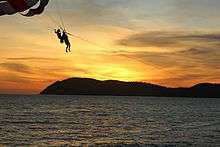
Langkawi receives more than 2,400 mm (94 in) of rain annually. Langkawi features a Tropical savanna climate (Köppen climate classification (Aw) ) Langkawi has a true dry season from December until February. March to November is a long rainy season. September is the wettest month, when it normally receives more than 500 mm (20 in).
| Climate data for Pulau Langkawi | |||||||||||||
|---|---|---|---|---|---|---|---|---|---|---|---|---|---|
| Month | Jan | Feb | Mar | Apr | May | Jun | Jul | Aug | Sep | Oct | Nov | Dec | Year |
| Record high °C (°F) | 36.2 (97.2) |
36.4 (97.5) |
37.2 (99.0) |
37.1 (98.8) |
37.0 (98.6) |
35.0 (95.0) |
33.8 (92.8) |
33.4 (92.1) |
33.9 (93.0) |
34.8 (94.6) |
35.1 (95.2) |
34.6 (94.3) |
37.2 (99.0) |
| Average high °C (°F) | 32.9 (91.2) |
33.2 (91.8) |
33.0 (91.4) |
32.3 (90.1) |
31.7 (89.1) |
31.5 (88.7) |
31.1 (88.0) |
30.9 (87.6) |
30.6 (87.1) |
30.7 (87.3) |
31.3 (88.3) |
31.6 (88.9) |
31.7 (89.1) |
| Daily mean °C (°F) | 28.0 (82.4) |
28.2 (82.8) |
28.3 (82.9) |
28.2 (82.8) |
28.1 (82.6) |
27.8 (82.0) |
27.5 (81.5) |
27.4 (81.3) |
27.0 (80.6) |
26.9 (80.4) |
27.3 (81.1) |
27.3 (81.1) |
27.7 (81.8) |
| Average low °C (°F) | 24.4 (75.9) |
24.4 (75.9) |
24.7 (76.5) |
25.0 (77.0) |
25.2 (77.4) |
24.9 (76.8) |
24.6 (76.3) |
24.7 (76.5) |
24.4 (75.9) |
24.3 (75.7) |
24.5 (76.1) |
24.4 (75.9) |
24.6 (76.3) |
| Record low °C (°F) | 19.8 (67.6) |
18.0 (64.4) |
21.5 (70.7) |
21.5 (70.7) |
22.7 (72.9) |
22.0 (71.6) |
21.1 (70.0) |
22.0 (71.6) |
22.0 (71.6) |
21.7 (71.1) |
22.1 (71.8) |
20.2 (68.4) |
18.0 (64.4) |
| Average precipitation mm (inches) | 23.9 (0.94) |
32.7 (1.29) |
104.8 (4.13) |
196.6 (7.74) |
206.9 (8.15) |
249.9 (9.84) |
265.5 (10.45) |
319.2 (12.57) |
340.6 (13.41) |
372.5 (14.67) |
193.0 (7.60) |
57.5 (2.26) |
2,363.1 (93.05) |
| Average precipitation days | 3 | 5 | 10 | 15 | 18 | 17 | 19 | 19 | 21 | 23 | 16 | 8 | 174 |
| Average relative humidity (%) | 70 | 71 | 76 | 81 | 83 | 84 | 84 | 84 | 85 | 85 | 81 | 75 | 80 |
| Source: Malaysian Meteorological Department[28] | |||||||||||||
Administrative divisions
Langkawi District is divided into 6 mukims, which are:
- Ayer Hangat
- Bohor
- Kedawang
- Kuah
- Padang Matsirat
- Ulu Melaka
Demographics
Only four of the 99 islands are inhabited: Langkawi (Pulau Langkawi, the main island), Tuba, Rebak and Dayang Bunting. The population is approximately 99,000, around 65,000 of them in Langkawi, of which 90% are Malays.[29] The other ethnic groups consist mainly of Chinese, Indians, and Thais.
Islam is practised primarily by ethnic Malays. Other major religions are Hinduism (mainly among Indians), Buddhism (mainly among Chinese and Thai), and Christianity (mostly Chinese).
Standard Malay is the official language and is used in formal occasions. English is widely spoken and understood by the locals. Most natives speak a Langkawi variant of Kedah Malay, with minorities also speaking Chinese, Siamese, and various Indian languages.
| Ethnic Group | 2010[30] | |
|---|---|---|
| Number | % | |
| Malay | 79,146 | 83.51% |
| Other Bumiputras | 153 | 0.16% |
| Chinese | 4,325 | 4.56% |
| Indian | 1,747 | 1.84% |
| Others | 217 | 0.23% |
| Non-Malaysian | 9,189 | 9.70% |
| Total | 94,777 | 100% |
Federal Parliament and State Assembly Seats
Langkawi district representatives in the Federal Parliament of Malaysia
| Parliament | Seat Name | Member of Parliament | Party |
|---|---|---|---|
| P4 | Langkawi | Mahathir Mohamad | Independent |
List of Langkawi district representatives in the state legislative assemblies
| Parliament | State | Seat Name | State Assemblyman | Party |
|---|---|---|---|---|
| P4 | N1 | Ayer Hangat | Juhari Bulat | Perikatan Nasional (PPBM) |
| P4 | N2 | Kuah | Mohd Firdaus Ahmad | Perikatan Nasional (PPBM) |
Economy
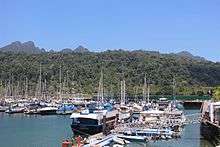
An agro-based economy of paddy and rubber cultivation and fisheries is being overtaken by a tourism-driven economy.
The Northern Corridor Economic Region (NCER) development program is a Malaysia Government initiative to accelerate economic growth in the north of Peninsular Malaysia – encompassing the states of Perlis, Kedah, Penang and the north of Perak. The target for NCER is to achieve increased tourism receipts per visitor from MYR1,890 (US$600) in 2005 to MYR3,034 (US$963) by 2012.
Annual tourist expenditure is targeted to increase from MYR9.0 billion (US$2.86 billion) in 2005 to MYR21.8 billion (US$6.9 billion) in 2012 and MYR64.5 billion (US$20.4 billion) in 2020.[31]
Tourism
On 1 June 2007, Langkawi Island was given a World Geopark status by UNESCO.[32] Three of its main conservation areas in Langkawi Geopark are Machincang Cambrian Geoforest Park, Kilim Karst Geoforest Park, and Dayang Bunting Marble Geoforest park (Island of the Pregnant Maiden Lake). These three parks are the most popular tourism area within Langkawi Geopark. In 2014, UNESCO issued a "yellow card" warning threatening the status of the Geopark.[33]
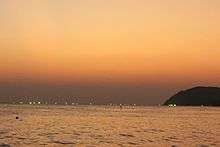
The Langkawi UNESCO Global Geopark status was due for renewal in 2015, of which upon thorough inspection by the appointed Geopark Inspectors, Langkawi was issued the Certificate of Membership dubbed the Green Card by Asia Pacific Geoparks Network, under the auspices of the Global Geopark Network (GGN).
Tourists can enter the island via ferry from Kuala Kedah, Kuala Perlis, and Penang. Or by domestic flight from Kuala Lumpur International Airport (KUL) via Malaysia Airlines, AirAsia, Malindo Air, or Subang Sultan Abdul Aziz Shah Airport (SZB) via Malindo Air and Fireflyz providing budget connection to the island. International connection is available from Singapore via Tigerair and AirAsia, as well as from Guangzhou via AirAsia.
Islands and beaches
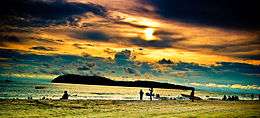
There are two main island areas: the Southern Islands, with a heavier tourist population, and the islands to the northeast which are more secluded with little tourist traffic. Langun Island has a fresh-water lake called Pregnant Maiden Lake and has a Sand Spit Beach on its south-facing orientation. Dendang Island next to it forms a bay used by Langkawi sailing yacht tour operators.[34]

Some of the most popular beaches are Pantai Cenang, Pantai Tengah, Burau Bay, Pantai Kok, and Datai Bay. Pantai Cenang beach has long stretches of fine white sand. It has a number of restaurants and bars for evening entertainment, several hosting live music and for watching the sun set. The beach is lined with tall coconut and casuarina trees. Pantai Tengah is separated from Cenang by a small cape. It also faces the setting sun and has hotels than bars, making it less busy in the evening. Burau Bay, fringed by rocky outcrops, is visited by migratory birds. Pantai Kok quiet beach has a backdrop of limestone hills. Datai Bay has a combination of forests and sea, its white sandy beach is backed by forest.
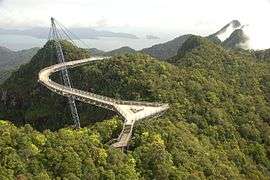
Cable car and Sky Bridge
The Langkawi Cable Car takes visitors up to the peak of Gunung Mat Chinchang, where the Langkawi Sky Bridge is located. The Sky Bridge was closed in 2012 for maintenance and upgrading, but reopened in February 2015. An inclined lift called SkyGlide that would takes visitors from the top station to the Sky Bridge was completed in late 2015.[35]
The start of cable car ride is located in the Oriental Village where there are a number of attractions, including a 3-Dimensional art museum known as Art in Paradise.[36]
The Kilim Karst Geoforest Park (The Kilim River)
The Kilim Karst Geoforest Park consists of three river estuaries that stretch from Kisap village approximately 10&km to Tanjung Rhu, and they are all interconnected. They are rich in wildlife with hairy nosed sea otters, brown winged kingfishers, monitor lizards, and swimming macaque monkeys being common sights. There is also a bat cave within the Geoforest Park.[37] Limestone, inherently porous, forms caves and there are several in the mangroves. One of Langkawi's natural beauty spots is the Pirate Lagoon just outside the river. Technically this is a collapsed cave (hong) consisting of a cave entrance from the sea emerging into a hidden lagoon with towering, limestone escarpments, and smaller caves.
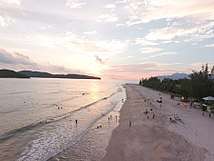
Activities
With Langkawi surrounded by the sea, there are various water-based activities to indulge in. For those that love cruises, there are various cruises that can accommodate for individuals that love the morning sun or individuals that would like to have dinner on a yacht.[39]
Snorkeling is also a popular activity, with operators organising daily tours to the nearby Payar Island (Malay: Palau Payar).
Tourists can also choose to go for island hopping tours with different options:
- Slow: Travelling and spending time on selective private islands / beaches
- Fast: Sitting on a speedboat for a quick spin around the various islands available in Langkawi
Transportation
The Island of Langkawi does not have public transportation, but the people can still use taxis or rent a vehicle (car, bicycle, motorbike, scooter, etc.). All taxis have a standard fixed price system with the fare from one part of the island to another is always being the same. As an alternative, ride hailing apps, such as Grab, also operate on the island.
The island of Langkawi can be reached by sea and air. The Langkawi Jetty Point connects the island to main destinations like Kuala Perlis, Kuala Kedah, Penang, and Tamalang. There's also ferry service to Satun town and to Ko Lipe island in Thailand.[40] From Langkawi, Malaysia, a ferry operates from Langkawi to Ko Lipe (and back) from October until June. The departure/arrival point in Langkawi is at Kuah Jetty, Langkawi and Telaga Harbour, Langkawi. The departure/arrival point in Ko Lipe is at Pattaya Beach. As there is no pier in Ko Lipe, transfers to the beach are done with local long-tail boats. The journey takes about 1 hour and 30 minutes.[41]
The Langkawi International Airport is one of the 7 international airports in Malaysia and connects the island to Kuala Lumpur, Singapore, Penang, and Subang. The main island is well-served by a number of roads.
Education
Secondary
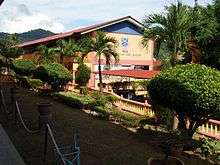
- SMK Ayer Hangat
- SMK Kedawang
- SMK Kelibang
- SMK Langkawi Pulau Tuba
- SMK Mahsuri
- SMK Tunku Putra
- Kolej Vokasional Langkawi
- Maktab Mahmud Langkawi
- Maktab Rendah Sains Mara Langkawi(MRSM)
Tertiary
- Kolej Komuniti Langkawi
Media
The television and radio in Langkawi can be received from Gunung Raya.and RTM Kuah.
FM Radio
- Langkawi FM - FM 87.50 MHz (RTM Kuah), FM 104.80 MHz (Gunung Raya)
- Era FM - FM 90.70 MHz (Gunung Raya)
- Hitz FM - FM 92.40 MHz (Gunung Raya)
- MY FM - FM 100.10 MHz (Gunung Raya)
- Sinar FM - FM 100.90 MHz (Gunung Raya)
- THR Raaga - FM 101.90 MHz (Gunung Raya)
- Kedah FM - FM 105.70 MHz (Gunung Raya)
- Radio Thailand Satun FM 95.5MHz and 99.5MHz (Satun, Thailand)
- MCOT Satun FM 93.25MHz (Satun, Thailand)
Image gallery
 Laman Padi Langkawi
Laman Padi Langkawi Langkawi Crocodile Farm
Langkawi Crocodile Farm Langkawi Craft and Cultural Complex
Langkawi Craft and Cultural Complex Beach monkey at Beras Basah Island
Beach monkey at Beras Basah Island Sunset at Cenang Island on Langkawi
Sunset at Cenang Island on Langkawi Machinchang Range towards Thailand and Pantai Cenang
Machinchang Range towards Thailand and Pantai Cenang Pulau Tepor from Cenang Beach
Pulau Tepor from Cenang Beach- Temurun Waterfall
International relations
Twin towns – Sister cities
Langkawi currently has two sister cities:
|
References
- primuscoreadmin (13 November 2015). "Background".
- "Population Distribution and Basic Demographic Characteristics, 2010" (PDF). Department of Statistics, Malaysia. Archived from the original (PDF) on 22 May 2014. Retrieved 19 April 2012.
- "TABURAN PENDUDUK MENGIKUT PBT & MUKIM 2010". Department of Statistics, Malaysia. Retrieved 15 December 2017.
- "Pantai Cenang - Everything you Need to Know About Pantai Cenang". langkawi-info.com. Retrieved 3 June 2019.
- "Shopping in Langkawi". ABC Langkawi. Archived from the original on 16 July 2012. Retrieved 11 August 2009.
- Mohamed Zahir Haji Ismail (2000). The Legends of Langkawi. Utusan Publications & Distributors.
- Holly Hughes; Sylvie Murphy; Alexis Lipsitz Flippin; Julie Duchaine (14 January 2010). Frommer's 500 Extraordinary Islands. John Wiley & Sons. p. 237. ISBN 978-0-470-59518-3. Retrieved 9 February 2014.
- Charles de Ledesma; Mark Lewis; Pauline Savage (2006). the Rough Guide to Malaysia, Singapore and Brunei (5th ed.). Rough Guides. p. 218. ISBN 978-1-84353-687-1.
- "Langkawi Eagle Square - Dataran Lang". Langkawi Insight.
- Maziar Mozaffari Falarti (2012). Malay Kingship in Kedah: Religion, Trade, and Society. Lexington Books. p. 94. ISBN 978-0-7391-6842-4.
- Braddell, Roland (December 1937). "An Introduction to the Study of Ancient Times in the Malay Peninsula and the Straits of Malacca". Journal of the Malayan Branch of the Royal Asiatic Society. 15 (3 (129)): 64–126. JSTOR 41559897.
- Mohamed Zahir Haji Ismail (2000). The Legends of Langkawi. Utusan Publications & Distributors.
- Majid, Embun (16 July 2008). "It's Langkawi Permata Kedah now". The Star Online. Archived from the original on 20 July 2008. Retrieved 20 July 2008.
- Maziar Mozaffari Falarti (2012). Malay Kingship in Kedah: Religion, Trade, and Society. Lexington Books. p. 55. ISBN 978-0-7391-6842-4.
- Maziar Mozaffari Falarti (2012). Malay Kingship in Kedah: Religion, Trade, and Society. Lexington Books. p. 99. ISBN 978-0-7391-6842-4.
- Ooi Giok Ling; Rahil Ismail; Brian J Shaw, eds. (2009). Southeast Asian Culture and Heritage in a Globalising World: Diverging Identities in a Dynamic Region. Ashgate Publishing Company. p. 50. ISBN 978-0-7546-7261-6.
- Mohamed Zahir Haji Ismail (2000). The Legends of Langkawi. Utusan Publications & Distributors. pp. 132–133.
- Maziar Mozaffari Falarti (2012). Malay Kingship in Kedah: Religion, Trade, and Society. Lexington Books. p. 119. ISBN 978-0-7391-6842-4.
- Maziar Mozaffari Falarti (2012). Malay Kingship in Kedah: Religion, Trade, and Society. Lexington Books. p. 121. ISBN 978-0-7391-6842-4.
- Stefan Eklöf (2006). Pirates in Paradise: A Modern History of Southeast Asia's Maritime Marauders. Nordic Institute of Asian Studies. p. 51. ISBN 978-87-91114-37-3.
- Anthony Spaeth (9 December 1996). "Bound for Glory". Time magazine. Archived from the original on 17 March 2009. Retrieved 13 September 2011.
- "Descendants of the White-Blooded Lady". Phuket Heritage.
- "Langkawi targets 4m tourists by year-end". Free Malaysia Today. 20 June 2013.
- "Tourist Statistics". Langkawi Development Authority. Archived from the original on 19 April 2015.
- "Geography". Langkawi Online. Archived from the original on 23 April 2015.
- "Langkawi History". 7 July 2009.
- C.P. Lee / Palaeoworld 15 (2006) 242–255, https://doi.org/10.1016/j.palwor.2006.10.007
- "Climate of Tourist Places in Malaysia – Pulau Langkawi (Redang Langkawi)". Met Office. Archived from the original on 20 August 2008. Retrieved 10 May 2019.
- "General Information". MyLangkawi.com.
- "Taburan Penduduk Dan Ciri-Ciri Asas Demografi 2010" (PDF). Department of Statistics, Malaysia. p. 63. Archived from the original (PDF) on 28 September 2011.
- Archived 21 November 2008 at the Wayback Machine
- "Langkawi given geopark status". The Star Online. 8 June 2007. Archived from the original on 9 September 2007. Retrieved 24 December 2007.
- "Langkawi risks losing Geopark status after Unesco 'Yellow Card'". Themalaysianinsider.com. Archived from the original on 28 November 2014. Retrieved 18 December 2014.
- "The Quick Guide to Things to do in Langkawi - Family Travel Blog - Travel with Kids". 29 March 2015. Retrieved 7 August 2016.
- "A Convenient Way To Visit SkyBridge". A Convenient Way To Visit SkyBridge. Archived from the original on 6 January 2016.
- "Tun Mahathir officiates Langkawi 3D art museum". The Sun Daily. 7 February 2015.
- Once in a Lifetime Journey. "Langkawi's Kilim Geoforest Park Tour".
- Once in a Lifetime Journey. "Casa Del Mar Langkawi: A Home by the Sea".
- "Day Cruise, Sunset Cruise, Private Cruise". Tropical Charters. Retrieved 12 January 2016.
- "Langkawi: Getting there and away". Travelfish.
- "KohLipe.my". Koh Lipe Tour Packages, Hotel, Ferry & Speed boat, Transfer & Snorkeling Trip. Retrieved 4 October 2017.
- "Senior KFZO Advisor, Malaysian Ambassador Meet in Kish". Kish Airlines. 4 January 2015. Archived from the original on 21 December 2015. Retrieved 21 December 2015.
External links
| Wikimedia Commons has media related to Langkawi District. |
| Wikivoyage has a travel guide for Langkawi. |
| Preceded by Kulim |
Capital of Kedah (1800–1864) |
Succeeded by Kulim |